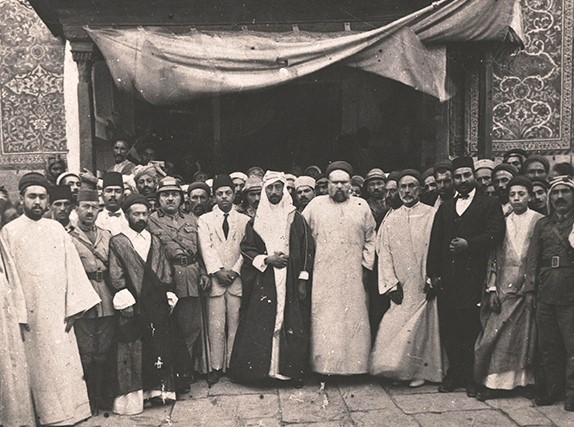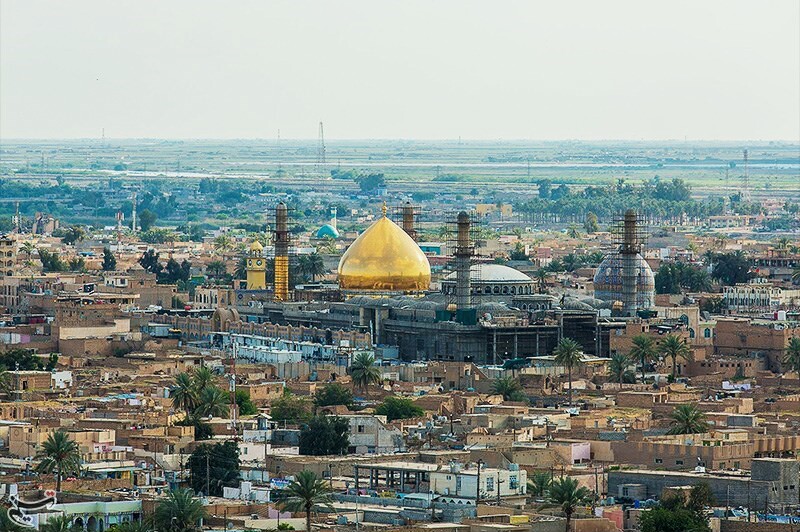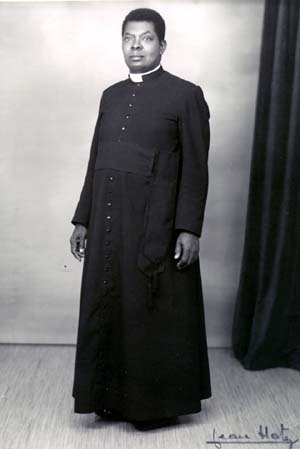|
Al Faiz Family
The family of Al Faiz (; ), also transliterated in a number of other ways, including Al Fa'iz, Al Fa'ez, Al Faez, or Al Fayez, is the oldest Alids, Alid family of Karbala, which they have occupied, on some occasions ruled, and held custodianship of its holy sites, since 861. They are the descendants of Ibrahim al-Mujab, the 9th-century grandson of the seventh Shi'ite Imam, Musa al-Kadhim. Their eponymous ancestor is considered to be Muhammad Abu al-Faiz, the 12th great-grandson of al-Mujab. In Karbala, the family holds a high prestige where they maintained the authority of the ''Naqib al-ashraf, niqaba'' (supervision) of Karbala's Sayyids and the ''sidana'' (custodianship) of Karbala's holy sites numerous times over different periods. The family is currently known by the families of Al Tumah, Al Nasrallah, Al Dhiya al-Din, Al Tajir, Al Awj, and Al Sayyid Amin. History Alid settlement in Karbala After al-Mutawakkil was killed in 861, the Alids found peace under his son, al-Mu ... [...More Info...] [...Related Items...] OR: [Wikipedia] [Google] [Baidu] |
Ibrahim Al-Mujab
Sayyid Ibrāhīm ibn Muḥammad ibn Mūsā al-Kāẓim () also known as Ibrāhīm al-Mujāb and al-Ḍarīr al-Kūfī, was the son of Muḥammad al-ʿĀbid, and grandson of Mūsā al-Kāẓim, the seventh Twelver Shia Imam.' He was the first Alid to settle in Karbala, where he died, and was buried in the Imam Husayn shrine. al-Mujab has many descendants that are known today by various names. Al Faiz is the only line of his that remained in Karbala until this day, since he settled in 861. As for his other descendants, most of them emigrated to other cities and countries, some of them are known today as Al Qazwini, Al Hamami, Al Awadi, Al Sabziwari, and Al Khirsan. It is also reported, that the scholars al-Sharif al-Radi and al-Murtada are descendants of al-Mujab. Biography The date and place of al-Mujab's birth are unknown. al-Mujab migrated from Kufa to Karbala in 861, after the Abbasid caliph al-Mutawakkil was killed at the hands of his son, al-Muntasir. al-Muntasir was ... [...More Info...] [...Related Items...] OR: [Wikipedia] [Google] [Baidu] |
Ibn Battuta
Ibn Battuta (; 24 February 13041368/1369), was a Maghrebi traveller, explorer and scholar. Over a period of 30 years from 1325 to 1354, he visited much of Africa, the Middle East, Asia and the Iberian Peninsula. Near the end of his life, Ibn Battuta dictated an account of his journeys, titled '' A Gift to Those Who Contemplate the Wonders of Cities and the Marvels of Travelling'', commonly known as ''The Rihla''. Ibn Battuta travelled more than any other explorer in pre-modern history, totalling around , surpassing Zheng He with about and Marco Polo with . Name "Ibn Battuta" is a patronymic, literally meaning 'son of a duckling'. His most common full name is given as Abu Abdullah Muhammad ibn Battuta. In his travelogue, '' The Rihla'', he gives his full name as " Shams al-Din Abu ’Abdallah Muhammad ibn ’Abdallah ibn Muhammad ibn Ibrahim ibn Muhammad ibn Yusuf Lawati al- Tanji ibn Battuta". Early life All that is known about Ibn Battuta's life comes from the au ... [...More Info...] [...Related Items...] OR: [Wikipedia] [Google] [Baidu] |
Patronymic
A patronymic, or patronym, is a component of a personal name based on the given name of one's father, grandfather (more specifically an avonymic), or an earlier male ancestor. It is the male equivalent of a matronymic. Patronymics are used, by custom or official policy, in many countries worldwide, although elsewhere their use has been replaced by or transformed into patronymic surnames. Examples of such transformations include common English surnames such as Johnson (surname), Johnson (son of John). Origins of terms The usual noun and adjective in English is ''patronymic'', but as a noun this exists in free variation alongside ''patronym''. The first part of the word ''patronym'' comes from Greek language, Greek πατήρ ''patēr'' 'father' (Genitive case, GEN πατρός ''patros'' whence the combining form πατρο- ''patro''-); the second part comes from Greek ὄνυμα ''onyma'', a variant form of ὄνομα ''onoma'' 'name'. In the form ''patronymic'', this stand ... [...More Info...] [...Related Items...] OR: [Wikipedia] [Google] [Baidu] |
Husayn Ibn Ali
Husayn ibn Ali (; 11 January 626 – 10 October 680 Common Era, CE) was a social, political and religious leader in early medieval Arabia. The grandson of the Islamic prophet Muhammad and an Alids, Alid (the son of Ali ibn Abu Talib ibn Abd al-Muttalib, Abi Talib and Muhammad's daughter Fatima), as well as a younger brother of Hasan ibn Ali, Husayn is regarded as the third Imam in Shia Islam after his brother, Hasan, and before his son, Ali al-Sajjad. Husayn is a prominent member of the Ahl al-Bayt and is also considered to be a member of the Ahl al-Kisa and a participant in the event of the mubahala, event of the ''mubahala''. Muhammad described him and his brother, Hasan, as the leaders of the youth of Paradise in Islam, paradise. During the caliphate of Ali, Husayn accompanied him in wars. After the assassination of Ali, he obeyed his brother in recognizing the Hasan–Muawiya treaty, Hasan–Mu'awiya I treaty, despite it being suggested to do otherwise. In the nine-year pe ... [...More Info...] [...Related Items...] OR: [Wikipedia] [Google] [Baidu] |
Samarra
Samarra (, ') is a city in Iraq. It stands on the east bank of the Tigris in the Saladin Governorate, north of Baghdad. The modern city of Samarra was founded in 836 by the Abbasid caliph al-Mu'tasim as a new administrative capital and military base. In 2003 the city had an estimated population of 348,700. During the Iraqi Civil War (2006–08), Samarra was in the " Sunni Triangle" of resistance. The archeological site of Samarra still retains much of the historic city's original plan, architecture and artistic relics. In 2007, UNESCO designated it a World Heritage Site. History Prehistoric Samarra The remains of prehistoric Samarra were first excavated between 1911 and 1914 by the German archaeologist Ernst Herzfeld. Samarra became the type site for the Samarra culture. Since 1946, the notebooks, letters, unpublished excavation reports and photographs have been in the Freer Gallery of Art in Washington, D.C. The civilization flourished alongside the Ubaid per ... [...More Info...] [...Related Items...] OR: [Wikipedia] [Google] [Baidu] |
Najaf
Najaf is the capital city of the Najaf Governorate in central Iraq, about 160 km (99 mi) south of Baghdad. Its estimated population in 2024 is about 1.41 million people. It is widely considered amongst the holiest cities of Shia Islam and one of its spiritual capitals, as well as the center of Shia political power in Iraq. It is the Imam Ali Shrine, burial place of Muhammad's son in law and cousin, ‘Alī ibn Abī Tālib, and thus a major pilgrimage destination for Shia Muslims. The largest cemetery in the world (Wadi-us-Salaam) and the oldest Shi'a Islamic seminary in the world (Hawza Najaf, Hawza of Najaf) are located in Najaf. Etymology According to Ibn Manzur, the word, "najaf" (), literally means a high and rectangular place around which water is accumulated, although the water does not go above its level. Al-Shaykh al-Saduq appeals to a hadith from Ja'far al-Sadiq, claiming that "Najaf" comes from the phrase, "nay jaff" which means "the nay sea has dried". "Naj ... [...More Info...] [...Related Items...] OR: [Wikipedia] [Google] [Baidu] |
Cassock
The cassock, or soutane, is a Christian clerical clothing, clerical coat used by the clergy and Consecrated life, male religious of the Oriental Orthodox Churches, Eastern Orthodox Church and the Catholic Church, in addition to some clergy in certain List of Protestant denominations, Protestant denominations such as Anglicanism, Anglicans and Lutheranism, Lutherans. "Ankle-length garment" is the literal meaning of the corresponding Latin term, . It is related to the Religious habit, habits traditionally worn by nuns, monks, and friars. The cassock derives historically from the tunic of classical antiquity that in ancient Rome was worn underneath the toga, and the Chiton (garment), chiton that was worn beneath the himation in ancient Greece. In religious services, it has traditionally been worn underneath vestments, such as the alb. In the West, the cassock is little used today except for religious services, save for Traditionalist Catholicism, traditionalist and those other C ... [...More Info...] [...Related Items...] OR: [Wikipedia] [Google] [Baidu] |
Shawl
A shawl (from ''shāl'') is a simple item of clothing, loosely worn over the shoulders, upper body and arms, and sometimes also over the head. It is usually a rectangular piece of Textile, cloth, but can also be Square (geometry), square or triangular in shape. Other shapes include oblong shawls. History Kashmir was a pivotal point in the history of the shawl, serving as the birthplace of one of the most coveted garments in the world. Perhaps the most widely known woven textiles are the famed Kashmir shawls. The ''Kanikar'', for instance, has intricately woven designs that are formalized imitations of nature. The ''Chinar'' leaf (plane tree leaf), ''apple and cherry blossoms'', the ''rose and tulip'', the ''almond and pear'', the ''nightingale''—these are done in deep mellow tones of maroon, dark red, gold yellow and browns. Yet another type of Kashmir shawl is the ''Jamia Vr'', which is a brocaded woollen fabric sometimes in pure wool and sometimes with a little cotton adde ... [...More Info...] [...Related Items...] OR: [Wikipedia] [Google] [Baidu] |
Vienna
Vienna ( ; ; ) is the capital city, capital, List of largest cities in Austria, most populous city, and one of Federal states of Austria, nine federal states of Austria. It is Austria's primate city, with just over two million inhabitants. Its larger metropolitan area has a population of nearly 2.9 million, representing nearly one-third of the country's population. Vienna is the Culture of Austria, cultural, Economy of Austria, economic, and Politics of Austria, political center of the country, the List of cities in the European Union by population within city limits, fifth-largest city by population in the European Union, and the most-populous of the List of cities and towns on the river Danube, cities on the river Danube. The city lies on the eastern edge of the Vienna Woods (''Wienerwald''), the northeasternmost foothills of the Alps, that separate Vienna from the more western parts of Austria, at the transition to the Pannonian Basin. It sits on the Danube, and is ... [...More Info...] [...Related Items...] OR: [Wikipedia] [Google] [Baidu] |
Ottoman Iraq
Ottoman Iraq () refers to the period of the history of Mesopotamia, Iraq when the region was ruled by the Ottoman Empire (1534–1920; with an interlude from 1704 to 1831 From Independence under the Mamluk dynasty (Iraq), Mamluk state of Iraq).Before reforms (1534–1704), Mesopotamia, Iraq was divided into four Eyalet, Eyalets (provinces): * Baghdad Eyalet * Shahrizor Eyalet * Basra Eyalet * Mosul Eyalet Ottoman Iraq was later (1831–1920) divided into the three vilayets (provinces): * Mosul Vilayet * Baghdad Vilayet * Basra Vilayet (Ottoman Empire), Basra Vilayet During World War I, an invasion of the region was undertaken by British Empire forces and was known as the Mesopotamian campaign. Fighting commenced with the Battle of Basra (1914), Battle of Basra in 1914 and continued for the duration of the war. The most notable action was the siege of Kut, which resulted in the surrender of the British and British Indian Army garrison of the town in April 1916, after a siege of 1 ... [...More Info...] [...Related Items...] OR: [Wikipedia] [Google] [Baidu] |
Fez (hat)
The fez (, ), also called tarboosh/tarboush (), is a felt headdress in the shape of a short, cylindrical, peakless hat, usually red, typically with a black tassel attached to the top. The name "fez" may refer to the Moroccan city of Fez, where the dye to color the hat was extracted from crimson berries. However, its origins are disputed. The modern fez owes much of its popularity to the Ottoman era. It became a symbol of the Ottoman Empire in the early 19th century. In 1827, Mahmud II mandated its use as a modern headdress for his new army, the Asakir-i Mansure-i Muhammediye. The decision was inspired by the Ottoman naval command, who had previously returned from the Maghreb having embraced the style. In 1829, Mahmud issued new regulations mandating use of the fez by all civil and religious officials. The intention was to replace the turban, which acted as a marker of identity and so divided rather than unified the population. A century later, in 1925, the fez was outlawed in ... [...More Info...] [...Related Items...] OR: [Wikipedia] [Google] [Baidu] |
Al-Ashraf Sha'ban
Al-Ashraf Zayn ad-Din Abu al-Ma'ali Sha'ban ibn Husayn ibn Muhammad ibn Qalawun (, better known as al-Ashraf Sha'ban ( or Sha'ban II, was a Turk Mamluk sultan of the Bahri dynasty in 1363–1377. He was a grandson of Sultan al-Nasir Muhammad (r. 1310–1341). He had two sons (out of a total of eight) who succeeded him: al-Mansur Ali and as-Salih Hajji. Biography Early life and family Sha'ban was born in 1353/54. His father was al-Amjad Husayn (died 1363), a son of Sultan an-Nasir Muhammad (r. 1310–1341) who, unlike many of his brothers, never reigned as sultan. Sha'ban's mother was Khawand Baraka (d. 1372), a former '' jarya'' slave woman who married al-Amjad Husayn. Sha'ban had four brothers, Anuk (d. 1390/91), Ibrahim, Ahmad and Janibak (d. 1428), and three sisters, Zahra (d. 1370), Shaqra (d. 1401) and Sara (d. 1432). Reign In late May 1363, the Mamluk magnates, in effect the senior emirs, led by Emir Yalbugha al-Umari, deposed Sultan al-Mansur Muhammad on charges of i ... [...More Info...] [...Related Items...] OR: [Wikipedia] [Google] [Baidu] |








